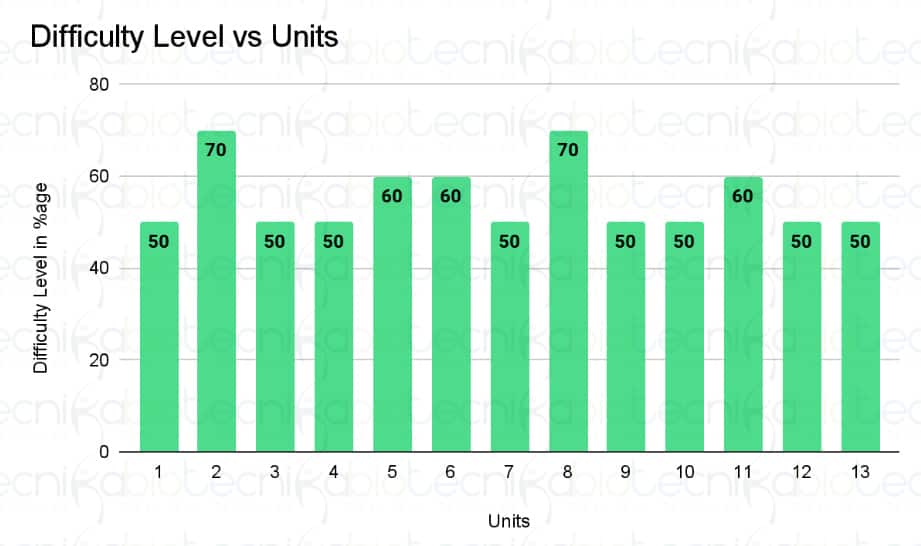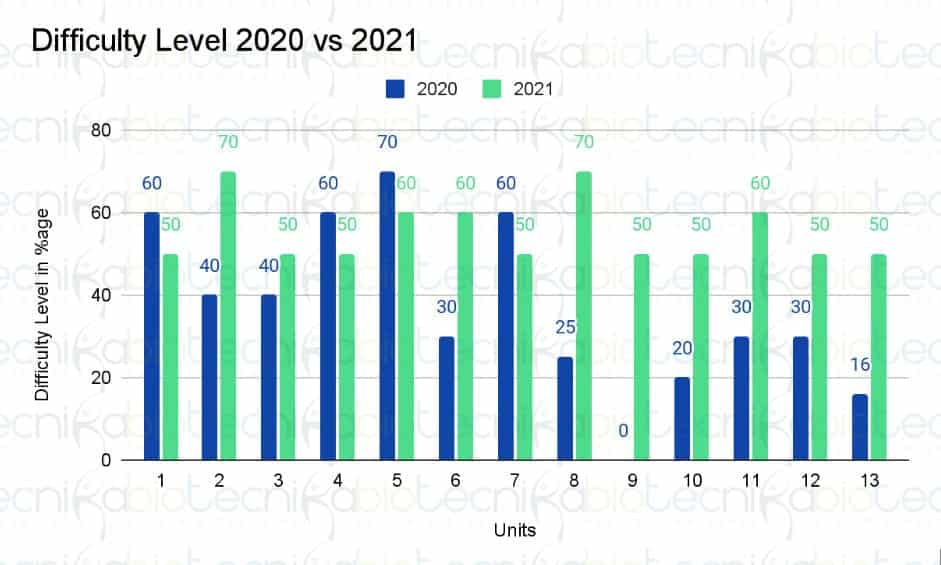CSIR June 2021 Cutoff Expected & Complete Analysis Unit Wise of Question Paper
Joint CSIR-UGC NET 2021 Exam was conducted successfully on 29 January 2022 and 15, 16 and 17 February 2022 covering 5 subjects in two shifts to determine the eligibility for Lectureship (LS)/Assistant Professorship in certain subject areas falling under the faculty of Science & Technology like Chemical Sciences, Earth, Atmospheric, Ocean and Planetary Sciences, Life Sciences, Mathematical Sciences, and Physical Sciences. From 22nd Feb 2022, the candidates who appeared in the exam could log in to the website, using their application number and date of birth, and click the link for the display of their question papers and marked responses and the provisional answer keys.
Biotecnika brings you a Complete Analysis of the CSIR NET June 2021 Exam in Life Sciences for Shift 1
Key Points
- The Question and marks distribution was the same as the previous CSIR NET examinations.
- One can select any of the 3 parts A, B & C and start answering.
- For each part, the question numbers are provided in the right column, so one can go through all the questions of that part by selecting the question number, Or one can go through the entire paper from the start – there is a different option for that, where the entire question paper is available in a word file.
- The number of questions attempted, answered, marked for review, and answered but marked for review will be shown.
- One can also check on the instruction page during the examination, if required, and can also change their preferred language.
Watch CSIR NET June 2021 Analysis Below
Overall Question CSIR NET 2021 Question Paper Analysis (Life Science)
As expected CSIR has maintained its high standards with a lot of analytical skills-based questions though there were a lot of surprise elements in this time’s paper. CSIR NET Life Sciences paper was moderate in difficulty level. Part-A was moderate in terms of difficulty level. Part-B can be considered as moderate as most of the questions stipulate an in-depth knowledge of the subject. Part C can be considered as moderate to difficult as the questions were analytical and reasoning based.
The Units that had the most difficult questions were asked in CSIR June 2021 Examination.
Among the 13 Units, the majority of the students found 2, 4 & 6 as the units from which most of the difficult questions were asked. There were quite a few deviations from the expected pattern of questions in the CSIR NET June 2021 Exam.
CSIR NET June 2021 Question Paper Review – Unit wise
General Aptitude:
Most questions are from the previous year’s CSIR Question Papers from all disciplines. Quite easy and straightforward questions, which can be answered with just a little bit of preparation.
Overall Difficulty Level – 30-40%
Unit 1 –
Breakdown of Questions – 14 questions (5 Part B + 9 Part C)
- All types of questions(concept-based, numerical, graph/plot based) from all topics of enzymes(kinetics, inhibition) were in abundance this time.
- 2nd most asked topic was amino acids, proteins, starting from properties, secondary structure, denaturation, techniques to study (like chromatographic separation, CD spectra etc).
- Questions from otherwise common topics like stabilizing interactions in macromolecules, pH buffer, thermodynamics, carbohydrates, Nucleic acids, and entire metabolism were completely missing this time.
Overall Difficulty Level – 50%
Unit 2 –
Breakdown of Questions – 10 questions (3 Part B and 7 Part C)
- Easy and direct questions came in Part B
- However, Part C was unexpectedly tough this time except for 1 question.
- Normally inhibitor related questions are easy and direct but this time, the reality was different. Actin inhibitors related question came which requires a detailed study about all the inhibitors.
- Cell cycle related questions were asked which were tough to answer, confusing statements especially related to RhoGTPases and cohesin.
Overall Difficulty Level – 70 %
Unit 3 –
Breakdown of Questions – 9 questions (5 Part B and 4 Part C )
- As expected to be in the approximate range of 8 – 12, 9 questions were asked from unit 3, 5 part B questions and 4 part C questions.
- The difficulty level was moderate as most of the questions were direct questions like those based on DNA repair mechanisms, Rho-dependent and independent transcription termination in bacteria or initiation of replication whereas only a few were indirect.
- This time an ample number of questions appeared from DNA replication alone both in part B and part C.
- 2 questions were framed from the fusion of unit 3 and unit 2 concept, cell cycle as always expected.
- Lytic and lysogenic cycle, RNA i were the other topics from where questions had appeared.
- Surprisingly translation and Operons had been ignored
Overall Difficulty Level – 50 %
Unit 4 –
Breakdown of Questions – 11 questions (5 Part B and 6 Part C)
- Easy and direct questions from Cell signalling, cancer.
- As expected always match the following from cellular communication(medium).
- Compared to previous exams this year very little focus on signalling based questions.
- Immunology combined cancer questions were asked this time(medium)
- As always one question came related to the causative agent.
Overall Difficulty Level – 50 %
Unit 5
Breakdown of Questions – 10 questions ( 5 Part B + 5 Part C)
- Questions from this unit were both direct(straightforward) and conceptual (transplantation experiment-based questions). As expected, questions were asked from early development, gastrulation, and axis formation of Sea Urchins, Amphibians, and Drosophila.
- The next topic of weightage was Limb development, cleavage divisions, Neurulation, and Arabidopsis development.
- Again, usual topics such as basic terminologies of development, fertilization, sex determination, C.elegans development, chick development were not given.
Overall Difficulty Level – 60%
Unit 6 –
Breakdown of Questions – 19 questions (5 part B+5 Part C)
- Questions this time from plant physiology were not usual and have changed the pattern
- Most of the questions were conceptual and analytical.
- Questions were picked up from some of the most important chapters of unit 6-Photosynthesis, Respiration, Sensory photobiology, Hormones and Secondary Metabolism according to our expectations.
- Part B questions were a bit analytical in comparison to part C based questions.
Overall Difficulty Level – 60%
Unit 7 –
Breakdown of Questions – 8 questions- (3 Part B + 5 Part C)
- Among the 5 part C questions asked, 3 were from respiration and others from endocrinology.
- This time most questions were asked from endocrinology, respiration and excretory systems.
- To our surprise, no questions were asked from the cardiovascular system, ECG, probably because in the last exam questions from this topic were asked. Even none of the questions were asked from the Nervous system, so in the next exam, we must expect questions from these topics.
- The questions asked are graph-based, statement-based, many questions were easy and can be solved with good preparation, except 2-3 which were difficult.
Overall Difficulty Level – 50%.
Unit 8 –
Breakdown of Questions – 8 (4 Part B + 4 Part C)
- 4 part B questions were there which were quite direct. It tested the concept of quantitative trait and qualitative trait, the principle of gene mapping by transformation, imprinting and the concept of penetrance and expressivity.
- There was 1 question that was linked with statistics under unit 13.
- 4 part C questions from concepts like linkage and marker, Pedigree and marker, quantitative trait and complementation group.
- The questions were not direct and difficult.
- All 8 questions were time-consuming and tested for the candidate’s IQ.
Overall Difficulty Level – 70%
Unit 9 –
Breakdown of Questions – 9 (3 Part B + 6 Part C)
- This time a lot of questions were asked from this unit.
- The questions were mostly plant-based.
- Mostly in form of match the column type
- 3 Part B question – based on animal disease, phylogenetic study and Pteridophyte life cycle
- The questions were easy and direct.
- 6 Part C questions- based on plant disease, movement of organisms, classification of Angiosperms, plant tissue organization, classification of the plant kingdom with examples and wildlife conservation.
- Anyone from a plant background will be delighted this time as mostly the questions used to be animal-based.
- This can be the scoring and game-changing unit for those who have prepared this unit.
Overall Difficulty Level – 50%
Unit 10 –
Breakdown of Questions – 9 (4 Part B + 5 Part C)
- Unit 10, always offers a chance to win good scores in the CSIR exam. this time too it came out with around 9 – 10 questions with 2 questions as a link with other units.
- All other frequently asked topics had been kept on preference this time too like population growth, ecological succession, ecogeographical rules, community attributes, island biogeography, mimicry, net primary productivity and the ozone layer.
- Numerical have not been asked, most of the questions were graph-based as expected which were quite easy to interpret.
- Seldom questions are asked from Unit 10 Part A, but this time 3 questions have been asked from this subunit only.
Overall Difficulty Level – 50%
Unit 11 –
Breakdown of Questions – 8 (4 Part B + 4 Part C)
- This time also graph-based questions were asked
- Expected kinds of questions from Geographical Time zones, H-W Equilibrium, Molecular evolution (gene duplication), and parental investment.
- Overall the questions were easy to moderate.
- Part C questions were difficult and one should have a very clear concept to answer.
Overall Difficulty Level – 60%
Unit 12 –
Breakdown of Questions – 2 (1 Part B + 1 Part C)
- Statement based question combining topics like Transgenic plants, Genomics from Unit 12 and ANOVA from Unit 13.
- Part C question was based on the development of transgenic plants.
- Genomics based questions were least expected but came this time. On the other hand, questions were expected from Agrobacterium and plant tissue culture was completely ignored.
- Questions required conceptual clarity.
Overall Difficulty Level – 50%
Unit 13 –
Breakdown of Questions – 14 Questions (5 Part B + 9 Part C)
Part B
- Questions were very direct based on the application of the techniques.
- Questions were direct based on techniques like a fluorescent microscope or framed by combining different techniques like Sequencing (Chain termination method, Pyrosequencing, Nanopore sequencing), Southern western blotting, Yeast two-hybrid system, PCR, Nuclear Magnetic Resonance (NMR), Markers.
- Questions were mainly asked from topics of Unit 13 subunit A (Molecular Biology and Recombinant DNA methods), B (Histochemical and Immunotechniques), and C (Biophysical method)
- One Numerical based question was also asked on protein concentration.
- Questions were easy to moderate
Part C
- All types of questions (Concept-based, Graph/Plot based, Match the following) questions were asked.
- Questions mainly asked were based on techniques like Spectroscopy (Circular Dichroism, NMR), Chromatography (Ion exchange, affinity), Map-based sequencing, Flow cytometry, Chi-square test, Inverse PCR, Mass Spectrometry, Optical Remote Sensing/EMR spectrum.
- Questions were mainly asked from topics of Unit 13 subunit A (Molecular Biology and Recombinant DNA methods), B (Histochemical and Immunotechniques),
- C (Biophysical Method) and also one question from subunit 13D (Statistical Methods) and 13 H (Methods in field Biology)
- Questions were mostly moderate to difficult required conceptual clarity.
Overall Difficulty Level – 50%.
CSIR June 2021 Cutoff Expected
According to the general consensus of the Biotecnika CSIR NET Experts – the CSIR June 2021 Cutoff will be high with 55.8%, 98.99 percentile for JRF(UR), 51.1%, 97.68 percentile for Lectureship (UR)
Summary
Overall the CSIR June 2021 Question Paper pattern was analytical and skill-based and needed a lot of in-depth knowledge of the subject. The analytical or logical questions needed a thorough understanding of the concepts, some questions did seem difficult and time-consuming. The format or the types of questions asked from units has gone through some changes. General Aptitude questions were easy and straightforward.
Suggestion for upcoming CSIR NET June 2021 exam aspirants:
- It is advised not to go through the whole set of question papers at the start of the exam. Instead, go part by part.
- Make the time distribution as(30 min for part A,1 Hr for part B, and 1.5 Hr for part C
- Even when you have selected a part, do not sit, and first, select the questions and then start answering. This was a common trend when it was an offline examination. But in this pattern, this approach will only kill time.
- Instead, start answering those questions which you are confident about. Since you can change the answer anytime there is no tension of marking the wrong one.
- So select your Part – advisable to start from Part C as it requires more time.
🔥 Preparing For CSIR NET June 2022 & Dec 2022? Learn From The Experts With RAID Techniques With Biotecnika – New Batch Starts From 4th March 2022 🔥
👉 Download CSIR NET June 2021 Question Paper Shift 1 + Detailed Answer Key Here👈
Keywords: CSIR June 2021 Cutoff Expected & Complete Analysis of Question Paper, CSIR NET 2021 Exam Question Paper & Answer Key, the Difficulty level of CSIR 2021 Life science exam, CSIR NET June 2021 Cut-Off Expected & Complete Analysis Unit Wise of Question Paper, CSIR June 2021 Cutoff, What is CSIR June 2021 Cutoff? What is the expected CSIR-NET June 2021 Cut-Off? CSIR June 2021 Cutoff Available










































